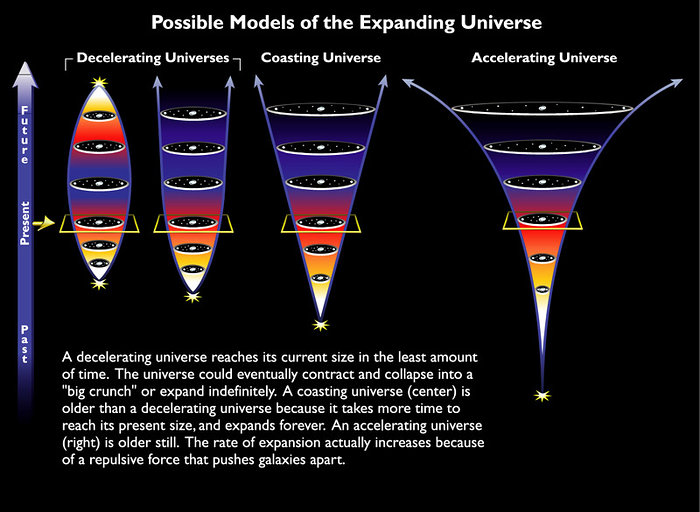Universe Models
16.12 - Understand that current models of the Universe predict different future evolutionary pathsMany cultures, religions and philosophies have given us different models of creation - how the world (and therefore Universe) was made. We will only look at some astronomical models here. The specification does not encourage a debate on philosophical beliefs but only on scientific ones.
We have moved from a flat Earth to a round one, and a geocentric model to a heliocentric one in our Solar System, putting the Sun at the centre. Although we give credit to Copernicus, the idea was around a long time before him. In the western world however, we had still clung on to the geocentric model.
It's easy to scoff at these old ideas now but imagine growing up without outside communications or education. You would see the land you are on as 'flat'. You would see Sun, planets and stars move around in the night sky.
Until galaxies were observed and known about, our Milky way was considered to be the whole Universe.
Einstein's general theory of relativity made scientists re-evaluate the knowledge they had. The Big Bang theory challenged the Steady State theory which said the Universe had no beginning or end. Cosmologists researched more and more into areas the Big Bang theory could not - and still cannot yet - answer.
The theory was formed from the evidence we had at the time, and most scientists think it is the best fit. Until many crucial questions are answered however, there is some uncertainty.
Some serious scientists propose a multiverse - many Universes, each having different laws, dimensions and time systems.
Debate also centres around how the Universe will end and when will it - with figures predicting between 3 and 20 billion years from now. Will it end? Will it expand forever or just stop expanding? Will it start to contract into itself? Does the universe recycle itself? Is this the first universe there has been?
Popular Models include:
The Big Rip
The Universe continues to expand but its expansion is so strong that it overcomes the gravty within it, atoms get torn apart and the structure of the universe deteriorates.
The Big Crunch
The Universe stops expanding and starts to contract. The universe starts to pull itself into a singularity as it was believed to have started from.
The Big Freeze
The Universe continues to expand but no new material for star formation exists, no energy or heat is available and the universe becomes a lifeless void.
Let's leave it on that cheery note. I hope you've enjoyed this course. Clear Skies!
Questions
What are the main scientific reasons why cosmologists cannot agree on a definite past and future model for the Universe?
Video - Powers of Ten
Video - The Universe
Links
- Chandra - Big Rip/Crunch animations
- Australia Telescope Outreach and Education Classical Astronomy


 | © All Rights Reserved |
| © All Rights Reserved |